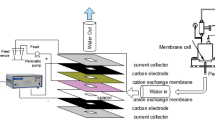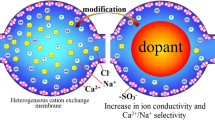Abstract
This work is devoted to assessment of the possibility of using ceramic membranes, which contain an ion-exchange component, such as hydrated zirconium dioxide (HZD), for Cr(VI) removal from dilute solutions by electrodialysis. Transport properties of the membranes were investigated. HZD-containing membranes were found to be permeable to anions in acidic media while they demonstrate cation-exchange properties in alkaline media. Cr(VI) anion transport through HZD membranes was studied. It was shown that an increase in the amount of ion-exchanger in the membrane results in a rise in electrodialysis efficiency. The transport number of Cr(VI) species was found to range from 0.33 to 0.63 for currents below the limiting current. It was also shown that increasing the concentration of H+ or Cr(VI) ions in the solution to be purified allows higher rate of Cr(VI) ion transport through the membrane.









Similar content being viewed by others
Abbreviations
- a :
-
activity (mol m−3)
- A :
-
area (m2)
- C Cr,s :
-
concentration of Cr(VI) in the bulk of solution (mol m−3)
- C 0Cr,s :
-
concentration of Cr(VI) in the solution at themembrane surface (mol m−3)
- D Cr,s :
-
Cr(VI) diffusion coefficient in the solution (m2 s−1)
- d :
-
distance between the membrane and cathode (m)
- E :
-
cell voltage (V)
- E m :
-
membrane potential (V)
- F :
-
Faraday constant (96485 A s mol−1)
- i :
-
membrane current density calculated with allowance for the outersurface area (A m−2)
- i Cr,lim :
-
limiting membrane current density caused by transport of Cr(VI) ions (A m−2)
- k Cr :
-
mass transport coefficient of Cr(VI) ions (m s−1)
- L :
-
membrane length (m)
- N Cr,m :
-
flux of Cr(VI) ions through the membrane (mol m−2 s−1)
- N Na,m :
-
flux of Na+ ions through the membrane (mol m−2 s−1)
- n Cr,a :
-
amount of Cr(VI) ions in the anolyte (mol)
- n Na,c :
-
amount of Na+ ions in the catholyte (mol)
- R :
-
gas constant (8.314 J mol−1 K−1)
- T :
-
temperature (K)
- t Cr,m :
-
transport number of Cr(VI) ions through the membrane (dimensionless)
- t Cr,s :
-
transport number of Cr(VI) ions through the solution (dimensionless)
- u :
-
superficial flow rate (for the cathode compartment) (m s−1)
- z :
-
charge of species (dimensionless)
- γ:
-
ratio of anion over cation valences (dimensionless)
- κ:
-
specific conductivity (Ohm−1 m−1)
- τ:
-
time (s, h)
- ν:
-
kinematic viscosity (m2 s−1)
- Re :
-
Reynolds number
- Sc :
-
Schmidt number
- Sh :
-
Sherwood number
References
Vallejo M.E., Persin F., Innocent C., Sistat Ph., Pourcelly G. (2000). Sep. and Pur. Techn. 21:61
Velizarova E., Ribeiro A.B., Ottosen L.M. (2002). J. Hazardous Materials 94:147
Roualdes S., Kourda N., Durand J., Pourcelly G. (2002). Desalination 146:273
C.A.M. Siskens, in A.J. Burggraaf and L. Cot (Eds) Fundamentals of Inorganic Membrane Science and Technology, (Elsevier, Amsterdam, 1996) pp. 619
Ahmed M.I., Chang H.T., Selman J.R., Holsen T.M. (2002). J. Membr. Sci. 197:63
Huang K.L., Holsen T.M., Selman J.R. (2002). J. Membr. Sci. 210:137
Pattanayak J., Mondal K., Wiltowski T., Lalvani S.B., Mandich N.V. (2000). Metal Finishing 98:39
Guddati S.L., Holsen T.M., Li C.C., Selman J.R., Mandich N.V. (1999). J. Applied Electrochem. 29:1129
Walsh F. (1993). A First Course in Electrochemical Engineering. Alresford Press, London, p 381
Linkov V.M., Belyakov V.N. (2001). Sep. and Purif. Technol. 25:57
Vesely V., Pekarek V. (1972). Talanta 19:219
Charlot G. (1961). Les Methodes de la Chimie Analytique. Masson, Paris p 1023 (in French)
Hale D.K., McCauley D.J. (1961). Trans. Farad. Soc. 57:135
Helfferich F. (1995). Ion Exchange. Dover, New York, p 624
Spoor P.B., ter Veen W.R, Janssen L.J.J. (2001). J. Appl. Electrochem. 31:523
Dzyazko Yu.S., Belyakov V.N. (2004). Desalination 162:179
Koryta J. (1991). Ions, Electrodes and Membranes. Wiley, Chichester, p. 197
Lever A.B.P. (1984). Inorganic Electronic Spectroscopy. Elsevier, Amsterdam
Koene L., Janssen L.J.J. (2001). Electrochim. Acta 47:695
J. Ciborowski, Podstawy Inzynierii Chemicznej (Naukovo-Techniczne Wydawnictwa, Warsaw, 1965) pp. 525 (in Polish)
Parsons R. (1959). Handbook of Electrochemical Constants. Butterworth Scientific Publications, London p 79
Sengupta A.K. (1995). Chromate Ion Exchange, Ion Exchange Technology: advances in pollution control. Technomic Publishing Co. Inc., Lancaster, p. 385
Acknowledgements
The work was performed within the framework of the joint French-Ukrainian “Dnipro” program (050806RL) supported by the EGIDE foundation (France) and Ministry of Education and Science of Ukraine (grant N 53 M/2004–23).
Author information
Authors and Affiliations
Corresponding author
Rights and permissions
About this article
Cite this article
Dzyazko, Y.S., Mahmoud, A., Lapicque, F. et al. Cr(VI) transport through ceramic ion-exchange membranes for treatment of industrial wastewaters. J Appl Electrochem 37, 209–217 (2007). https://doi.org/10.1007/s10800-006-9243-7
Received:
Accepted:
Published:
Issue Date:
DOI: https://doi.org/10.1007/s10800-006-9243-7




